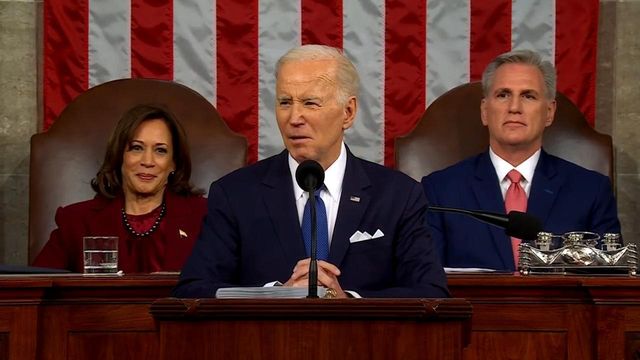Fact-checking President Biden's State of the Union speech
President Joe Biden delivered his second State of the Union address on Tuesday.
Posted — UpdatedHere is a fact check of some of the claims from Biden:
Cutting the deficit
Biden said, "In the last two years, my administration has cut the deficit by more than $1.7 trillion -- the largest deficit reduction in American history."
Facts First: Biden's boast leaves out important context. It is true that the federal deficit fell by $1.7 trillion under Biden in the 2021 and 2022 fiscal years, including a record $1.4 trillion drop in 2022 -- but it is highly questionable how much credit Biden deserves for this reduction. Biden did not mention that the primary reason the deficit fell so substantially was that it had skyrocketed to a record high under then-President Donald Trump in 2020 because of bipartisan emergency pandemic relief spending, then fell as expected when the spending expired as planned. Independent analysts say Biden's own actions, including his laws and executive orders, have had the overall effect of adding to current and projected future deficits, not reducing those deficits.
Dan White, senior director of economic research at Moody's Analytics -- an economics firm whose assessments Biden has repeatedly cited during his presidency -- told CNN's Matt Egan in October: "On net, the policies of the administration have increased the deficit, not reduced it." The Committee for a Responsible Federal Budget, an advocacy group, wrote in September that Biden's actions will add more than $4.8 trillion to deficits from 2021 through 2031, or $2.5 trillion if you don't count the American Rescue Plan pandemic relief bill of 2021.
National Economic Council director Brian Deese wrote on the White House website in January that the American Rescue Plan pandemic relief bill "facilitated a strong economic recovery and enabled the responsible wind-down of emergency spending programs," thereby reducing the deficit; David Kelly, chief global strategist at J.P. Morgan Funds, told CNN in October that the Biden administration does deserve credit for the recovery that has pushed the deficit downward. And Deese correctly noted that Biden's signature legislation, last year's Inflation Reduction Act, is expected to bring down deficits by more than $200 billion over the next decade.
Still, the deficit-reducing impact of that one bill is expected to be swamped by the deficit-increasing impact of various additional bills and policies Biden has approved.
From CNN's Daniel Dale
Small business applications
Biden said that "over the last two years, a record 10 million Americans applied to start new businesses."
Facts First: This is true. There were about 5.4 million business applications in 2021, the highest number since 2005 (the first year for which the federal government released this data for a full year), and about 5.1 million business applications in 2022. Not every application turns into a real business, but the number of "high-propensity" business applications -- those deemed to have a high likelihood of turning into a business with a payroll -- also hit a record in 2021 and saw its second-highest total in 2022.
Former President Donald Trump's last full year in office, 2020, also set a then-record for total and high propensity applications. There are various reasons for the pandemic-era boom in entrepreneurship, which began after millions of Americans lost their jobs in early 2020. Among them: some newly unemployed workers seized the moment to start their own enterprises; Americans had extra money from stimulus bills signed by Trump and Biden; interest rates were particularly low until a series of rate hikes that began in the spring of 2022.
From CNN's Daniel Dale
Unemployment among demographic groups
Biden said there is "near record unemployment for Black and Hispanic workers."
Facts First: Biden's claims are accurate.
The Black or African American unemployment rate was 5.4% in January 2023, just above the record low of 5.3% set in August 2019. (This data series goes back to 1972.) The rate was 9.2% in January 2021, the month Biden took office.
The Hispanic or Latino unemployment rate was 4.5% in January 2023, not too far from the record low of 4.0% that was set in September 2019 -- though the 4.5% rate in January 2023 was a jump from the 4.1% rate in December 2022. (This data series goes back to 1973.) The rate was 8.5% in January 2021.
Daniel Dale
Trump and the national debt
Biden criticized the fiscal management of former President Donald Trump's administration -- saying that "nearly 25% of the entire national debt, a debt that took 200 years to accumulate, was added by just one administration alone -- the last one."
Facts First: Biden's claim is correct. The national debt, now more than $31 trillion, increased by just under $8 trillion during Trump's four years in office, in part because of Trump's major tax cuts. It's important to note, though, that some of the increase in the debt during the Trump era was because of the trillions in emergency Covid-19 pandemic relief spending that passed with bipartisan support. The national debt spiked in the first half of 2020 after increasing gradually during Trump's first three years in office, and because of spending required by safety-net programs that were created by previous presidents. A significant amount of spending under any president is the result of decisions made by their predecessors.
Charles Blahous, a researcher at the Mercatus Center at George Mason University who authored the 2021 paper "Why We Have Federal Deficits," wrote that the impact of recent legislation on the long-term structural fiscal imbalance is dwarfed by the creation of Medicare and Medicaid and increases to Social Security, all of which occurred between 1965 and 1972.
"Despite all the political rhetoric expended today to cast blame for skyrocketing federal deficits on either the Joseph R. Biden Jr. administration or the Donald J. Trump administration, on either congressional Democrats or congressional Republicans, the largest drivers of the structural federal fiscal imbalance were enacted roughly a half-century ago," Blahous wrote.
From CNN's Katie Lobosco and Daniel Dale
The-CNN-Wire™ & © 2023 Cable News Network, Inc., a Warner Bros. Discovery Company. All rights reserved.
Related Topics
Copyright 2024 by Cable News Network, Inc., a Time Warner Company. All rights reserved.






